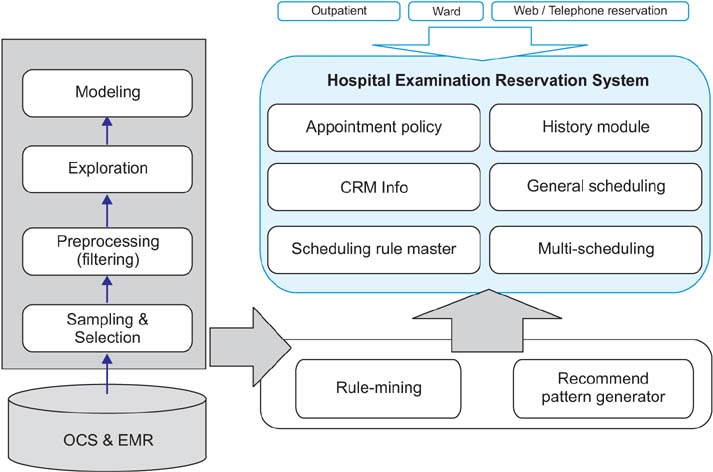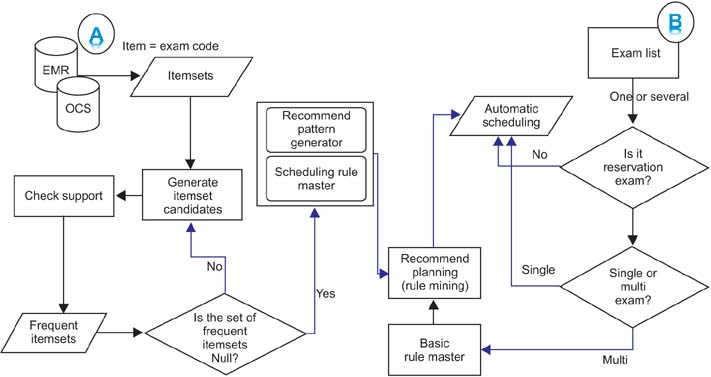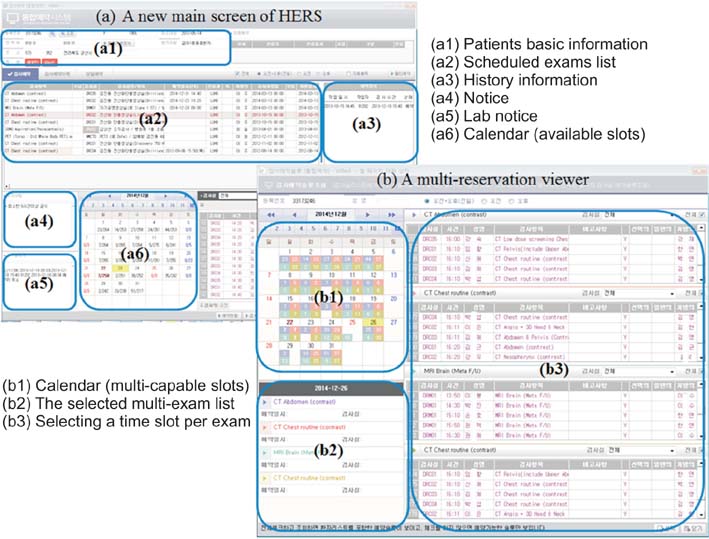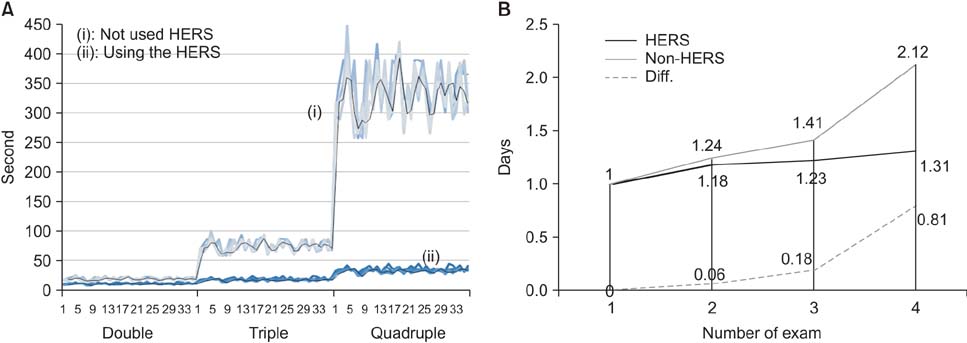Healthc Inform Res.
2015 Apr;21(2):95-101. 10.4258/hir.2015.21.2.95.
Implementation of Hospital Examination Reservation System Using Data Mining Technique
- Affiliations
-
- 1Information Technology Team, National Cancer Center, Goyang, Korea. shchung@ncc.re.kr
- 2Patient Affair Team, National Cancer Center, Goyang, Korea.
- 3Database/Bioinformatics Laboratory, Chungbuk National University, Cheongju, Korea.
- KMID: 2284612
- DOI: http://doi.org/10.4258/hir.2015.21.2.95
Abstract
OBJECTIVES
New methods for obtaining appropriate information for users have been attempted with the development of information technology and the Internet. Among such methods, the demand for systems and services that can improve patient satisfaction has increased in hospital care environments.
METHODS
In this paper, we proposed the Hospital Exam Reservation System (HERS), which uses the data mining method. First, we focused on carrying clinical exam data and finding the optimal schedule for generating rules using the multi-examination pattern-mining algorithm. Then, HERS was applied by a rule master and recommending system with an exam log. Finally, HERS was designed as a user-friendly interface.
RESULTS
HERS has been applied at the National Cancer Center in Korea since June 2014. As the number of scheduled exams increased, the time required to schedule more than a single condition decreased (from 398.67% to 168.67% and from 448.49% to 188.49%; p < 0.0001). As the number of tests increased, the difference between HERS and non-HERS increased (from 0.18 days to 0.81 days).
CONCLUSIONS
It was possible to expand the efficiency of HERS studies using mining technology in not only exam reservations, but also the medical environment. The proposed system based on doctor prescription removes exams that were not executed in order to improve recommendation accuracy. In addition, we expect HERS to become an effective system in various medical environments.
Keyword
MeSH Terms
Figure
Reference
-
1. Felfernig A, Mandl M, Tiihonen J, Schubert M, Leitner G. Personalized user interfaces for product configuration. In : Proceedings of the 15th International Conference on Intelligent User Interfaces; 2010 Feb 7-10; Hong Kong, China. p. 317–320.2. Korean Statistical Information Service. Social survey medical services dissatisfied reasons (primary response, and 13 years of age or older) [Internet]. Daejeon: Korean Statistical Information Service;c2014. cited at 2014 Dec 4. Available from: http://kosis.kr/statHtml/statHtml.do?orgId=101&tblId=DT_1SS14HE111R&vw_cd=MT_OTITLE&list_id=MT_CTITLE_gE_2014&scrId=&seqNo=&lang_mode=ko&obj_var_id=&itm_id=&conn_path=E1.3. Jeong BH, Choi JT, Park SS. An implementation of medical treatment schedule guidance system for inpatients satisfaction improvement. J Korean Inst Inf Technol. 2012; 10(2):88–93.4. Hwang EJ. Effects of job satisfaction and patients satisfaction on medical profit at public hospitals. Korean J Hosp Manag. 2014; 19(2):11–20.5. Park SH. Analysis of factors delaying on waiting time for medical examination of outpatient on a hospital. J Korean Soc Qual Improv Health Care. 2001; 8(1):56–72.6. Hwang JI. Factors influencing consultation time and waiting time of ambulatory patients in a tertiary teaching hospital. J Korean Soc Qual Assur Health Care. 2006; 12(1):6–16.7. Ko YK. The Relationships among Waiting Time, Patient's Satisfaction, and Revisiting Intention of Outpatients in General Hospital. J Korean Acad Nurs Adm. 2010; 16(3):219–228.
Article8. Park IS, Kim JS, Kim SS, Kim EJ, Choi HS, Kang SH. A study on the efficient flow of health examinees. J Digit Converg. 2014; 12(2):379–389.
Article9. Lee JK, Kim MK, Ha BH. Evaluation of appointment policy and scheduling rule for a dental clinic based on computer simulation. Korean J Hosp Manag. 2011; 16(4):161–182.10. Hung SY, Hung WH, Tsai CA, Jiang SC. Critical factors of hospital adoption on CRM system: organizational and information system perspectives. Decis Support Syst. 2010; 48(4):592–603.
Article11. Goldberg D, Nichols D, Oki BM, Terry D. Using collaborative filtering to weave an information tapestry. Communications of the ACM. 1992; 35(12):61–70.
Article12. Yeom JK. Kang CY. The critical factors on improvement of medical institution competitiveness. Korean J Hosp Manag. 2007; 12(1):1–30.13. Anneke Fitzgerald J, Dadich A. Using visual analytics to improve hospital scheduling and patient flow. J Theor Appl Electron Commer Res. 2009; 4(2):20–30.
Article14. Cao XJ. Medical Equipment reservation system based on hospital data integration platform. Adv Mater Res. 2014; 912:1291–1293.
Article15. Wang DX, Hu XG, Liu XP, Wang H. association rules mining on concept lattice using domain knowledge. In : Proceedings of 2005 International Conference on Machine Learning and Cybernetics; 2005 Aug 18-21; Guangzhou, China. p. 2151–2154.16. Lee SY, Lee KJ. Pattern classification model design and performance comparison for data mining of time series data. J Korean Inst Intell Syst. 2011; 21(6):730–736.
Article17. Hill W, Stead L, Rosenstein M, Furnas G. Recommending and evaluating choices in a virtual community of use. In : Proceedings of the SIGCHI Conference on Human Factors in Computing Systems; 1995 May 7-11; Denver, CO. p. 194–201.18. Sarwar B, Karypis G, Konstan J, Riedl J. Item-based collaborative filtering recommendation algorithms. In : Proceedings of the 10th International Conference on World Wide Web; 2001 May 1-5; Hong Kong, China. p. 285–295.19. Choi HS, Ji EH, Kang SH. A study on the improvement of outpatient process using simulation. J Digit Converg. 2014; 12(8):377–387.
Article20. Najmuddin AF, Ibrahim IM, Ismail SR. A simulation approach: improving patient waiting time for multiphase patient flow of obstetrics and gynecology department (O&G Department) in Local specialist centre. WSEAS Trans Math. 2010; 9(10):778–790.
- Full Text Links
- Actions
-
Cited
- CITED
-
- Close
- Share
- Similar articles
-
- Development of Customer Relationship Management System in the Healthcare Domain Using Data Mining
- Developing a Statistical Software for Predicting Hospital Bankruptcy using Data Mining Tool
- Data Mining Application for Knowledge Management in Medical Field
- Multiagent System using Data Mining Technique for the Management of Asthma in Mobile Computing Environments
- Development of Health Insurance Rate-Setting System Utilizing Data Mining Technique





